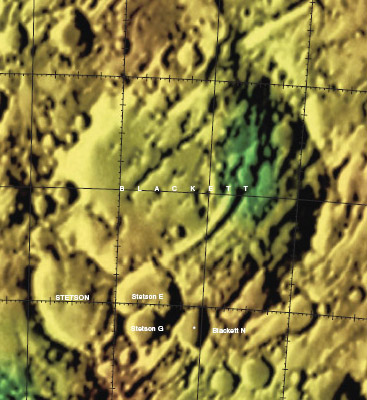Blackett
Contents
Blackett
| Lat: 37.5°S, Long: 116.1°W, Diam: 141 km, Depth: km, Rükl: (farside) | |
Images
LPOD Photo Gallery Lunar Orbiter Images
Maps
(LAC zone 122B4) USGS Digital Atlas PDF
Description
Blackett, a crater that formed during the pre-Nectarian period (~ 4.6 to 3.92 bn years), has been through the wars! Not only has it been battered to death by ejecta from the nearby Orientale Basin some 800 kilometres off to its north-east, but it also has taken its fair share of ejecta from the Mendel-Rydberg Basin some 350 kilometres away to its south-east. One would strain to see the effects of this latter event that occurred during the Nectarian period (~ 3.92 to 3.85 bn years), however, the former event which happened during the Early Imbrium period (~ 3.8 to 3.2 bn years) has left Blackett scarred for life. Obvious gouged striations running radial to Orientale's direction are easily seen, and most, if not all, of Blackett's northern rim-region shows signs of batterment. In the opposite, southern direction, the rim does look relatively better in comparison, however, several fairly big-ish craters ranging from 20 to 50 kilometes across have left their mark. In all, the crater's rim has been well worned down, its floor gouged and pummelled, and in general its entire face has taken on a less-than characteristic appearance for a crater of its age. All this warring and wearing-down has thus left Blackett a decrepit old man too long in the tooth for any more fighting.- JohnMoore2
Description: Wikipedia
Additional Information
Is there a large unnamed crater south-southeast of Blackett (see LAC 122 in the Clementine Atlas)?. The centre of this unnamed crater is located at approximately 44° South/ 114° West.
Nomenclature
- Named for Patrick Maynard Stuart Blackett (November 18, 1897 - July 13, 1974), an English experimental physicist known for his work on cloud chambers, cosmic rays, and paleomagnetism. He received the 1948 Nobel Prize for Physics for his investigation of cosmic rays using his invention of the counter-controlled cloud chamber.
- Blackett appears in a list of names for possible future use on the Moon published in IAU Transactions XVIB (1976).
- It was "approved as assigned" in IAU Transactions XVIIB (1979).
- Not to be confused with Brackett.
LPOD Articles
Bibliography
Blackett's group of five magnetic stars
On pages 601 and 602 of the book Mysterious Universe, a handbook of astronomical anomalies (W.R.Corliss, The Sourcebook Project, 1979) a certain Blackett is mentioned who seems to had (or have) something with a group of five magnetic stars, see article Existence of Net Electrical Charges on Stars (V.A.Bailey, Nature, 1960). Is this the same Blackett as the one described above in the Nomenclature section? - DannyCaes Mar 7, 2015

